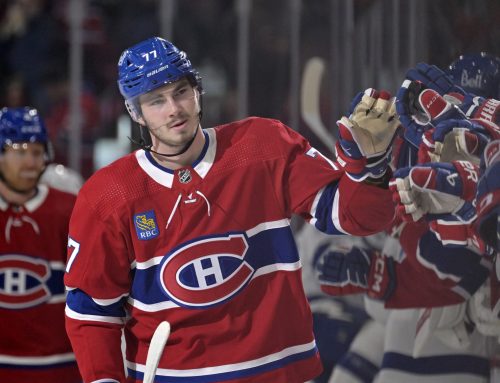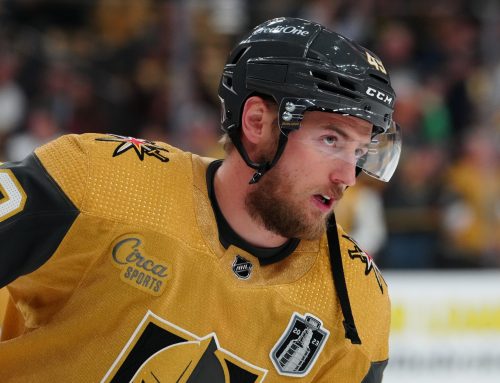Frozen Tools Forensics: Rebounds to Glory
Chris Kane
2020-07-17
As I explore the Dobber Reports, I continue to find really interesting reports and applications. There is a ton of data to sift through and many ways to look at it. We have had a bit of a mini-series on shots over the last year and I want to continue that today. This time I want to take a look at some data we have around shot type and how it can help us think about player style and goal potential. There are a couple of directions to take this, and we may revisit over the coming weeks, but to start us off we are going to look at shots and goals off of rebounds.
As with all Dobber reports, the focus of today's column is aptly named. Sh% by Type shows the various ways players can put the puck on net (slapshot, wrist shot, deflection etc.) and breaks it out by player. This way we can do quite a bit of sorting and see who is taking a lot of what kind of shots and how effective they are at doing so.
To get things started, take a look at the below table. It is an abbreviated version of the full report. In this case it is sorted by total number of slapshots, but we can see that for each kind of shot the report is broken down into total goals scored, shots on goal in that shot variety, and shooting percentage.
| Wrist | Backhand | Slap | ||||||||||
| Name | Pos | GP | Goals | G | SOG | SH% | G | SOG | SH% | G | SOG | SH% |
| RYAN PULOCK | D | 68 | 10 | 5 | 64 | 7.8 | 0 | 1 | 0 | 4 | 89 | 4.5 |
| BRENT BURNS | D | 70 | 12 | 4 | 94 | 4.3 | 1 | 5 | 20 | 5 | 87 | 5.7 |
| P.K. SUBBAN | D | 68 | 7 | 1 | 33 | 3 | 0 | 8 | 0 | 4 | 83 | 4.8 |
| NEAL PIONK | D | 71 | 6 | 2 | 76 | 2.6 | 1 | 5 | 20 | 3 | 80 | 3.8 |
| ALEX OVECHKIN | L | 68 | 48 | 20 | 139 | 14.4 | 2 | 22 | 9.1 | 12 | 79 | 15.2 |
When sorted by total slapshots, we see mostly defenders at the top of the list, with Ryan Pulock leading the way. This makes sense as a lot of the slapshots come from further out where there is a bit more time and space to wind up. Alex Ovechkin, the only forward in the top five, is a man unto himself as his shot totals are huge and he typically sets up at the top of the circles which gives him the time and space for a slapshot. He also mans the point on the power play (and if you remember from an earlier post, he spends basically the entire power play there).
This display gives us each player's individual shooting percentage, but it is helpful to level set a bit. What kinds of shooting percentages do we expect a player to have based on the shot type? There is a ton that goes into that consideration that we don't have here (shot distance, screens, one timers, etc.), but we can use this data set to give us some rough estimates.
| G | SOG | Sh% | |
| Wrist | 3356 | 38046 | 8.82% |
| Backhand | 612 | 5385 | 11.36% |
| Slap | 662 | 9910 | 6.68% |
| Tip In | 614 | 3710 | 16.55% |
| Snap | 947 | 8962 | 10.57% |
| Wrap-around | 44 | 611 | 7.20% |
| Deflected | 203 | 1338 | 15.17% |
| Off Rebound | 593 | 2046 | 28.98% |
A couple of things jump out right away. Wrap-arounds are not very effective and
pretty rare (they account for less than one percent of the total shots recorded here). Slapshots are also very inefficient comparably, but also do tend to lead to deflections and rebounds which are much more effective, so we should give them a bit of credit. Wrist shots are by far the most common shot, accounting for 54 percent of all shots taken. The next highest by percent are slapshots at 14 percent. And finally, rebounds are the most effective way to put the puck in the next, with an almost 30 percent conversion rate. Unfortunately, rebounds are also pretty rare, accounting for just three percent of the total shots taken. That does beg the question of who is taking these shots? Are there some players who are doing this significantly better than other players?
The answer from this data set? Hard to tell.
| Off Rebound | ||||||||
| Name | Pos | Age | Team | GP | Goals | G | SOG | SH% |
| CRAIG SMITH | C | 30 | NSH | 69 | 18 | 4 | 15 | 26.7 |
| ADAM HENRIQUE | C | 30 | ANA | 71 | 26 | 4 | 14 | 28.6 |
| BRADY TKACHUK | L | 20 | OTT | 71 | 21 | 4 | 13 | 30.8 |
| EVGENII DADONOV | R | 31 | FLA | 69 | 25 | 3 | 11 | 27.3 |
| PATRICK KANE | R | 31 | CHI | 70 | 33 | 3 | 11 | 27.3 |
| MATTHEW TKACHUK | L | 22 | CGY | 69 | 23 | 1 | 11 | 9.1 |
| EVANDER KANE | L | 28 | S.J | 64 | 26 | 5 | 11 | 45.5 |
| ANDREI SVECHNIKOV | R | 20 | CAR | 68 | 24 | 2 | 11 | 18.2 |
| PATRIC HORNQVIST | R | 33 | PIT | 52 | 17 | 1 | 11 | 9.1 |
| ALEX OVECHKIN | L | 34 | WSH | 68 | 48 | 2 | 10 | 20 |
The league leader in this category, Craig Smith, has just 15 shots off of rebounds. The tenth ranked player (Ovechkin) has ten, and furthermore there are ten players tied with ten shots off of rebounds. With sample sizes that small and that well distributed it is hard to draw any really meaningful conclusions.
Yet logic would imply that there are some players who should be in better positions to get these kinds of shots than others. Positions, team offensive zone strategies, and player roles particularly on the power play definitely suggest that some players are going to be in a place to get these kinds of shots while others will not. For example, there are only three defensemen in the top 50 for total shots off of rebounds. That trend holds true in past years, with only one defenseman in the top 50 in 2018-19. This makes sense as defensemen are rarely positioned close in on the net where they might pick up a rebound.
And there is a sort of pattern to the player arrangement. In 2019-20 there are 33 players ranked in the top third of shots of rebound. Over the last three seasons 17 of those 33 players appeared in the top third at least one other time. Additionally, three of them appeared in all three seasons. Those three are Evander Kane, Patric Hornqvist, and James van Riemsdyk.
Kane, Hornqvist, and Van Riemsdyk have quite a few similarities. For starters they are all wingers, and wingers who are known to have a bit more of an edge to their game – the guys who are not afraid to "get a little dirty" and go to the hard spots (i.e. the corners, and the front of the net). They are also players who have generally taken a higher volume of shots and have played relatively similar roles on the power play.
We see this style of play and role manifest itself with another useful Dobber Report, helpfully entitled Shots. We have looked at it before, but if we pull out the shot location data for these three players, they are remarkably similar.
| Name | SOG 0-15 | 0-15 % | SOG 16-30 | 16-30 % | SOG 31-45 | 31-45 % |
| EVANDER KANE | 71 | 40.11% | 64 | 36.16% | 42 | 23.73% |
| PATRIC HORNQVIST | 79 | 55.24% | 34 | 23.78% | 30 | 20.98% |
| JAMES VAN RIEMSDYK | 80 | 61.07% | 35 | 26.72% | 16 | 12.21% |
Kane takes more shots than the other two, so his differences are a bit less pronounced. He is a bit lower in the 0-15-foot range, and van Riemsdyk lower in the 31-45-foot range. Overall though the trends are very similar. These are guys that play close to the net and are therefore more likely to get those rebound opportunities.
All things said and done, it does appear that rebounds are the most effective way of scoring, and that some players are in better position to get those rebound opportunities. The difficulty lies in that the number of opportunities a player gets over the course of the season is often so small we are not always able to translate the knowledge into fantasy success. It is worth noting that a player who is transitioning into one of these roles though could well be in for an increase in these high-quality opportunities and hopefully therefore production.
That is all for this week. Thanks for reading.
Stay safe out there.
Want more tool talk? Check out these recent Frozen Tool Forensics Posts.
Frozen Tool Forensics: Sorting Through Defensive Prospects





 TOR
TOR BOS
BOS DAL
DAL VGK
VGK EDM
EDM L.A
L.A COL
COL FLA
FLA T.B
T.B VAN
VAN WPG
WPG NYR
NYR BUF
BUF
